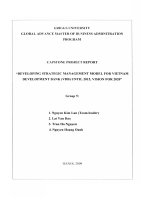Strategic management planning for domestic and global competition 14th ed pearce robinson chapter 14
Bạn đang xem bản rút gọn của tài liệu. Xem và tải ngay bản đầy đủ của tài liệu tại đây (337.7 KB, 29 trang )
Chapter 14
Innovation and
Entrepreneurship
© 2015 by McGraw-Hill Education. This is proprietary material solely for authorized instructor use. Not authorized for sale or distribution
in any manner. This document may not be copied, scanned, duplicated, forwarded, distributed, or posted on a website, in whole or part.
Learning Objectives
• Summarize the difference between incremental
and breakthrough innovation.
• Explain what is meant by continuous improvement
and how it contributes to incremental innovation
• Summarize the risks associated with an
incremental versus a breakthrough approach to
innovation.
• Describe the three key elements of the
entrepreneurship process.
• Explain intrapreneurship and how to enable it to
thrive.
Invention vs. Innovation
•
Invention is the creation of new products
or processes through the development of
new knowledge or from new
combinations of existing knowledge
3
Invention vs. Innovation (contd.)
•
Innovation is the initial commercialization of
invention by producing and selling a new
product, service, or process
• Product innovation
• Service innovation
• Process innovation
4
Incremental Innovation
•
Incremental innovation refers to simple changes
or adjustments in existing
–
products
–
services
–
or processes
Continuous Improvement
• The process of relentlessly trying to find ways
to improve and enhance a company’s
products and processes from design through
assembly, sales, and service. It is called kaizen
in Japanese. It is usually associated with
incremental innovation.
Incremental Innovation
•
Toyota’s CCC21: construction of cost
competitiveness for the 21st century
•
Six Sigma is a rigorous and analytical approach
to quality and continuous improvement with an
objective to improve profits through defect
reduction, yield improvement, improved
consumer satisfaction, and best-in-class
performance
Ex. 14.2
The DMAIC Six Sigma Approach
8
Six Sigma – Developing a Customer Orientation
9
10 Essential Elements that
Lead to Incremental Innovation
1. Define quality and
customer value
2. Develop a customer
orientation
3. Focus on the company’s
business processes
4. Develop customer and
supplier partnerships
5. Take a preventive
approach
6. Adopt an error-free
attitude
7. Get the facts first
8. Encourage every
manager and employee
to participate
9. Create an atmosphere
of total involvement
10. Strive for continuous
improvement
Breakthrough Innovation
•
A breakthrough innovation is an innovation
in a product, process, technology, or the cost
associated with it that represents a quantum
leap forward in one or more of those ways
•
Breakthrough approaches to innovation are
inherently more risky than incremental
innovation approaches
Ex. 14.3
From Idea to Profitable Reality
Characteristics of Successful Innovations
1.
2.
3.
4.
5.
Moderately new to the marketplace
Based on tried and tested methodology
Saved money for users of the innovation
Reportedly met customer needs
Supported existing practices
The Economist
Idea Factors
•
Need spotting
•
Solution spotting
•
Mental inventions
•
Random events
•
Market research
•
Trend following
Risks Associated with Innovation
•
Innovation involves creating something that
doesn’t now exist
•
Long odds for success
•
Market risk
•
Technology risk
Ex. 14.5
Risks Associated with Innovation
Disruptive Innovation
• A term to characterize breakthrough
innovation popularized by Harvard Professor
Clayton Christensen; usually shakes up or
revolutionizes industries with which they are
associated even though they often come from
totally different origins or industry settings
than the industry they “disrupt.”
Treacy’s Useful Points about Managing Risks
• The point of innovation is growth
• Get the most from the minimum innovation
• Incremental product innovations can lock in existing
customers
• Incremental business process innovations can
generate more revenue gain or cost savings with less
risk than radical ones
• Radical innovations are often too radical
• The time to launch breakthrough innovations is
when they are essential to the marketplace
Ways to Lower Risk
•
Product teams
•
Cross-functional groups
•
Joint ventures
•
Cooperation with lead users
•
“Do it yourself” innovation
•
Acquiring innovation
•
Outsourcing innovation
Ideagoras
• A web-enabled, virtual marketplace which
connects people with unique ideas, talents,
resources, or capabilities with companies
seeking to address problems or potential
innovations in a quick, competent manner.
Ex. 14.8
Who is the Entrepreneur?
Entrepreneurship
• Entrepreneurship is the process of bringing
together creative and innovative ideas and
actions with the management and
organizational skills necessary to mobilize
the appropriate people, money, and
operating resources to meet an identifiable
need and create wealth in the process
Entrepreneurs vs. Others
• Entrepreneurs are different from
– Inventors
– Promoters
– Administrators
• Entrepreneurs (unlike the above three) are
high on both creativity/ innovativeness and
management skills/business know-how.
Three Elements Central to Entrepreneurial
Process
1. Opportunity
2. Entrepreneurial Teams
3. Resources
Resources
1. Debt financing is generally obtained from a
commercial bank to pay for property,
equipment, and maybe provide working
capital
2. Equity financing is usually obtained from
one or more of three sources: friendly
sources, informal venture investors, or
professional venture capitalists









